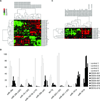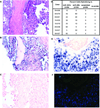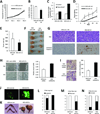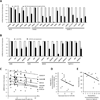miRNA signatures associate with pathogenesis and progression of osteosarcoma
- PMID: 22350417
- PMCID: PMC3328547
- DOI: 10.1158/0008-5472.CAN-11-2663
miRNA signatures associate with pathogenesis and progression of osteosarcoma
Abstract
Osteosarcoma remains a leading cause of cancer death in adolescents. Treatment paradigms and survival rates have not improved in two decades. Driving the lack of therapeutic inroads, the molecular etiology of osteosarcoma remains elusive. MicroRNAs (miRNAs) have demonstrated far-reaching effects on the cellular biology of development and cancer. Their role in osteosarcomagenesis remains largely unexplored. Here we identify for the first time an miRNA signature reflecting the pathogenesis of osteosarcoma from surgically procured samples from human patients. The signature includes high expression of miR-181a,miR-181b, and miR-181c as well as reduced expression of miR-16, miR-29b, and miR-142-5p. We also demonstrate that miR-181b and miR-29b exhibit restricted expression to distinct cell populations in the tumor tissue. Further, higher expression of miR-27a and miR-181c* in pre-treatment biopsy samples characterized patients who developed clinical metastatic disease. In addition, higher expression of miR-451 and miR-15b in pre-treatment samples correlated with subsequent positive response to chemotherapy. In vitro and in vivo functional validation in osteosarcoma cell lines confirmed the tumor suppressive role of miR-16 and the pro-metastatic role of miR-27a. Furthermore, predicted target genes for miR-16 and miR-27a were confirmed as down-regulated by real-time PCR. Affymetrix array profiling of cDNAs from the osteosarcoma specimens and controls were interrogated according to predicted targets of miR-16, miR142-5p, miR-29b, miR-181a/b, and miR-27a. This analysis revealed positive and negative correlations highlighting pathways of known importance to osteosarcoma, as well as novel genes. Thus, our findings establish a miRNA signature associated with pathogenesis of osteosarcoma as well as critical pre-treatment biomarkers of metastasis and responsiveness to therapy.
©2012 AACR.
Conflict of interest statement
Figures





Similar articles
-
miR-27a and miR-27a* contribute to metastatic properties of osteosarcoma cells.Oncotarget. 2015 Mar 10;6(7):4920-35. doi: 10.18632/oncotarget.3025. Oncotarget. 2015. PMID: 25749032 Free PMC article.
-
MicroRNA-27a promotes proliferation, migration and invasion by targeting MAP2K4 in human osteosarcoma cells.Cell Physiol Biochem. 2014;33(2):402-12. doi: 10.1159/000356679. Epub 2014 Feb 11. Cell Physiol Biochem. 2014. PMID: 24556602
-
Role of miRNA-542-5p in the tumorigenesis of osteosarcoma.FEBS Open Bio. 2020 Apr;10(4):627-636. doi: 10.1002/2211-5463.12824. Epub 2020 Mar 18. FEBS Open Bio. 2020. PMID: 32105410 Free PMC article.
-
MicroRNA profiling identifies MiR-195 suppresses osteosarcoma cell metastasis by targeting CCND1.Oncotarget. 2015 Apr 20;6(11):8875-89. doi: 10.18632/oncotarget.3560. Oncotarget. 2015. PMID: 25823925 Free PMC article.
-
Delivery of miRNAs Using Nanoparticles for the Treatment of Osteosarcoma.Int J Nanomedicine. 2024 Aug 22;19:8641-8660. doi: 10.2147/IJN.S471900. eCollection 2024. Int J Nanomedicine. 2024. PMID: 39188861 Free PMC article. Review.
Cited by
-
LncRNA SNHG10 increases the methylation of miR-218 gene to promote glucose uptake and cell proliferation in osteosarcoma.J Orthop Surg Res. 2020 Aug 26;15(1):353. doi: 10.1186/s13018-020-01865-6. J Orthop Surg Res. 2020. PMID: 32843060 Free PMC article.
-
Arid1a Loss Enhances Disease Progression in a Murine Model of Osteosarcoma.Cancers (Basel). 2024 Jul 31;16(15):2725. doi: 10.3390/cancers16152725. Cancers (Basel). 2024. PMID: 39123453 Free PMC article.
-
Involvement and Clinical Aspects of MicroRNA in Osteosarcoma.Int J Mol Sci. 2016 Jun 3;17(6):877. doi: 10.3390/ijms17060877. Int J Mol Sci. 2016. PMID: 27271607 Free PMC article. Review.
-
miR-181c associates with tumor relapse of high grade osteosarcoma.Oncotarget. 2015 Jun 10;6(16):13946-61. doi: 10.18632/oncotarget.3539. Oncotarget. 2015. PMID: 26062442 Free PMC article.
-
MiR-142-5p promotes bone repair by maintaining osteoblast activity.J Bone Miner Metab. 2017 May;35(3):255-264. doi: 10.1007/s00774-016-0757-8. Epub 2016 Apr 16. J Bone Miner Metab. 2017. PMID: 27085967
References
-
- Ottaviani G, Jaffe N. The epidemiology of osteosarcoma. Cancer Treat Res. 2009;152:3–13. - PubMed
-
- Gorlick R. Current concepts on the molecular biology of osteosarcoma. Cancer Treat Res. 2009;152:467–478. - PubMed
-
- Bacci G, Bertoni F, Longhi A, Ferrari S, Forni C, Biagini R, et al. Neoadjuvant chemotherapy for high-grade central osteosarcoma of the extremity. Histologic response to preoperative chemotherapy correlates with histologic subtype of the tumor. Cancer. 2003;97:3068–3075. - PubMed
-
- Lewis BP, Burge CB, Bartel DP. Conserved seed pairing, often flanked by adenosines, indicates that thousands of human genes are microRNA targets. Cell. 2005;120:15–20. - PubMed
Publication types
MeSH terms
Substances
Grants and funding
LinkOut - more resources
Full Text Sources
Other Literature Sources
Medical
Molecular Biology Databases

